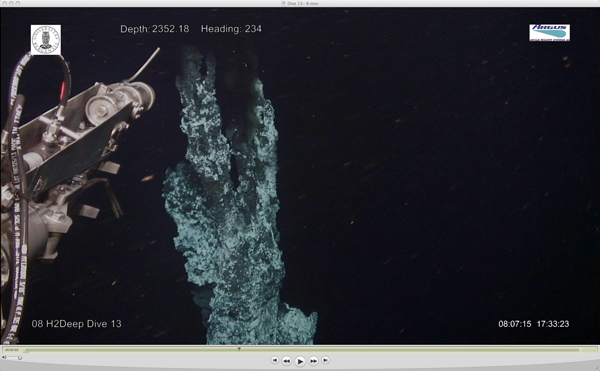The InterRidge Office has just received news that the world's most northerly black smoker hydrothermal vent field was discovered at 2400m in the North Atlantic at 73°N. The discovery occurred on July 12, 2008, during a cruise led by Rolf B. Pedersen, Professor of Geology and leader of the Centre for Geobiology at the University of Bergen, Norway. The cruise included PIs from Norway, Portugal, Switzerland, and USA.
 |
Press release from Dr. Pedersen:
"12 July 2008 researchers from the Centre for Geobiology at the University of Bergen in Norway led an expedition that discovered the world’s most northerly black smoker hydrothermal vents and possibly one of the world’s largest seafloor hydrothermal sulphide deposits. The vents were found along the northerly Arctic portion of Mid-Atlantic Ridge at 73°N about 300km from the nearest land, Bear Island. The expedition included some of the Centre’s international partners from the University of Washington, the University of Lisbon and ETH-Zurich, Switzerland.
Using state-of-the-art technology, researchers aboard the Norwegian research vessel, the G.O.Sars, conducted extensive mapping of the region, followed by water chemistry analysis using CTDs and finally launched an ROV (Remotely Operated Vehicle), the Bathysaurus, produced by Argus Remote System AS, a Norwegian company, to explore the sea floor. The dramatic sea-floor terrain and great depth added to the difficulty of the search. This summer’s cruise built on the cumulative results of nearly a decade of research.
The first black smoker found has a chimney of around 11m high. Within a radius of around 100m an additional five other black smokers were also found. The field has been named Loki’s Castle because the turrets and small chimneys of the field appear like a fantasy castle. Loki is a Norwegian god renowned for trickery: an appropriate name for a field that was so difficult to locate.
The Loki’s Castle smokers are located on mounds of mineral-rich material that has precipitated out when the mineral rich, super-heated water met the very cold waters of the deep sea. Surrounding the chimneys researchers found a rich ecosystem based on chemosynthesis for energy. Preliminary observations suggest that the ecosystem around these Arctic vents is diverse and appears to be unique, unlike the vent communities observed elsewhere. Samples have been collected for study.
The hydrothermal field is located on top of a linear deep-sea volcano, one of the many thousand that are found along the Mid-Atlantic Ridge. As the continental plates move apart at the Ridge, hot mantle material rises and melts forming magma. Lava flows out on the sea floor periodically creating new crust. Water that has percolated down through the crust becomes super-heated at depths of several thousands of meters below the surface. The hot water dissolves minerals in the crust as it returns to the surface. These minerals form the smoke and the chimneys as they precipitate out when the hot water meets the much colder sea water. The water emerging from the smokers here measured over 300ºC.
The spreading rate of the northerly Mid-Atlantic Ridge is so slow that researchers did not believe that such a large and long-lived hydrothermal field would be found along this portion of the global ridge system. However, this belief will have to be reconsidered after the discovery of two fields near Jan Mayen Island in 2005 and this summer’s find. It is clear that the geodynamics of the sea-floor in the very northerly portion of the Atlantic is complex and only partly understood.
The cruise was led by Rolf B. Pedersen, Professor of Geology and leader of the Centre for Geobiology. The Centre is one of the Norwegian Research council’s newest Centre of Excellence. There were 25 participants from five different countries, including two teachers who were responsible for the web-based cruise diary. (www.geobio.uib.no)."
Read more about the discovery on the cruise website:
http://www.geobio.uib.no/View.aspx?mid=1062&itemid=90&pageid=1090&module...
Note: The northernmost hydrothermal vent field in the InterRidge Global Database of Hydrothermal Vents is at 82.883°N - the "Aurora" site at which a hydrothermal plume was detected and shimmering water observed in a camera tow (Edmonds et al. 2003. Discovery of abundant hydrothermal venting on the ultraslow-spreading Gakkel ridge in the Arctic Ocean. Nature 421: 252-256).




